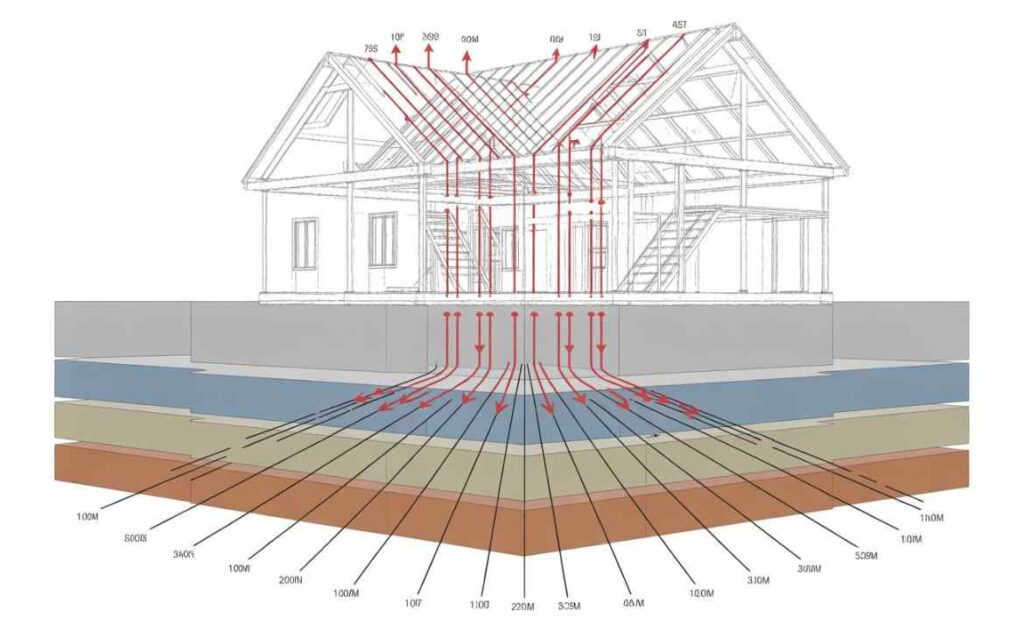Homeowners often do not think about the foundation until a contractor points out a crack or moisture issue. Understanding what a footing and stem wall foundation does can help you protect the structure of your home and avoid expensive repairs later. After years of working on residential foundation systems across the United States, one truth stands out. Good structure always starts at the ground.
This guide explains what a footing and stem wall foundation is, how it is built, the most common issues that appear over time, and how professionals repair those problems to maintain structural safety.
What Is a Footing and Stem Wall Foundation?
A footing and stem wall foundation is one of the most widely used raised foundation systems in residential construction. It includes two core components that work together to transfer the building’s weight safely into the soil:
• Footing
A wide, reinforced concrete slab installed below ground level. It acts like a strong shoe that spreads the structure’s load over a larger soil area.
• Stem Wall
A vertical concrete or masonry wall built on top of the footing. It creates the perimeter of the home and elevates the floor system above the ground, forming a crawl space.
Most stem walls extend about 18 inches to 24 inches above grade, with a similar portion buried beneath the soil. Builders often reinforce the wall by filling concrete block cavities with rebar and concrete for improved load capacity.
Many homeowners appreciate this foundation style because it provides better ventilation, protection from flooding in coastal areas, and easier access for plumbing and electrical repairs compared to slab foundations.
How This Foundation Works
The footing handles the compression forces from the home, distributing weight into supportive soil. The stem wall lifts the home above ground while serving as the connection point for wood framing.
This system prevents wood structural components from directly contacting soil and moisture. When correctly designed and properly reinforced, it offers decades of reliability even in moderately unstable soil conditions.

Common Problems with Footing and Stem Wall Foundations
Like all Footing and Stem Wall foundation systems, issues can develop from environmental stress, shifting soil, or inadequate moisture control. Common problems include:
1. Concrete Spalling
Surface flaking or crumbling caused by moisture intrusion, freeze-thaw cycles, or poor drainage. This weakens the structural integrity of the wall.
2. Exposed or Corroded Rebar
Corrosion expands the steel, which pushes apart the concrete. If ignored, entire wall sections can eventually separate from the footing.
3. Settlement Cracks
Differential settlement from weak soils or seismic activity creates cracks that widen over time. Even hairline cracks require evaluation, particularly when accompanied by uneven floors or gaps around doors.
4. Moisture and Crawl Space Humidity
High humidity promotes mold growth, wood rot, and the degradation of support beams. Moisture management is crucial for long lifespan performance.
Homeowners often mistake the footing and stem wall Foundation as the same element. Technically, the footing is the buried horizontal support, while the stem wall is the vertical perimeter above it. Understanding the difference helps when discussing repairs with a specialist.
Professional Repair Solutions for Stem Wall and Footing Damage
The right repair depends on the specific problem and soil behavior. Foundation repair companies commonly use:
• Underpinning with Helical or Push Piers
A long-term structural solution for settlement. Steel piers transfer home loads deeper into stable soil or bedrock, returning the structure to level where possible.
• Epoxy Injection or Carbon Fiber Reinforcement
Effective for stabilizing non-structural cracks and improving tensile strength. Carbon fiber straps keep cracks from expanding and minimize future movement.
• Concrete Restoration and Waterproofing
For spalling and rebar exposure, damaged sections are removed, steel is repaired or replaced, and new protective concrete or coatings are applied.
• Crawl Space Moisture Management
Solutions include vapor barriers, sump pumps, and improved drainage to prevent ongoing water-related deterioration.
No foundation repair should be delayed. Small cracks become bigger. Moisture damage spreads. Timely intervention protects your property and preserves safety for everyone inside the home.
When Should You Call a Professional?
Schedule a foundation inspection if you notice any of the following:
• Cracks in stem walls, drywall, or exterior siding
• Doors and windows sticking or misaligned
• Floors that feel uneven or bouncy
• Water entry or mold in the crawl space
• Rust stains and concrete fragments around perimeter walls
Early diagnosis typically results in lower repair costs and a more effective structural outcome.

Final Thoughts
A footing and stem wall foundation is strong, efficient, and widely used across the country. With proper drainage, reinforcement, and routine inspection, it can support your home reliably for generations. If you suspect foundation changes, a qualified repair specialist can evaluate the structure and provide the most appropriate long-term solution.
Safeguarding the integrity of your foundation is one of the best investments you can make in your home’s future.
FAQs
What is a footing and stem wall foundation?
A footing and stem wall foundation combines a concrete base underground with a raised wall above ground to support the home and distribute its weight evenly.
What is a stem foundation?
A stem foundation uses a vertical concrete or masonry wall that sits on a footing to elevate and support the structure above the soil.
What is the purpose of a stem wall?
A stem wall keeps the home level, protects it from moisture and pests, and adds strength between the footing and the building structure.
Which comes first, footing or foundation?
The footing is built first because it forms the base that supports the stem wall and the rest of the foundation.

